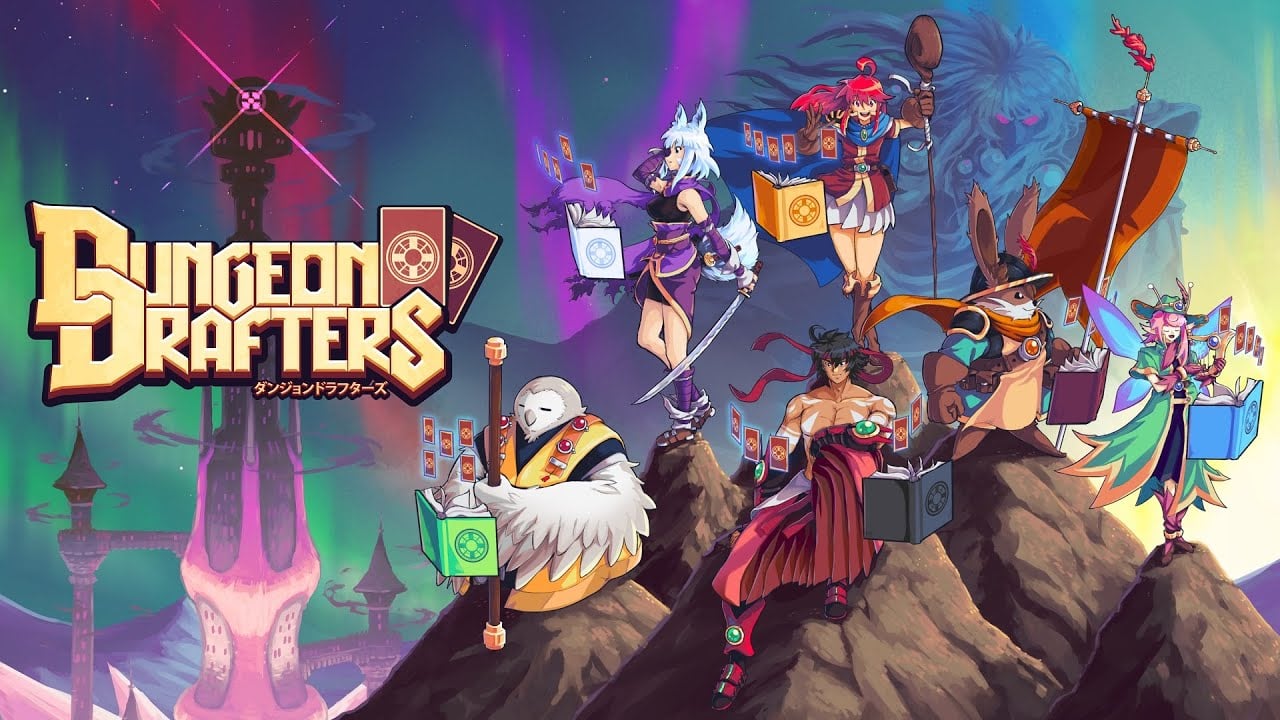Ever played a Pokémon Mystery Dungeon game and thought “Huh, I wish I was rescuing booster packs instead”? Me neither. I can’t deny it’s an enticing idea, though. A more traditional dungeon crawler might have you finding yet another rusty broadsword, destined to be turned into a meager amount of coins because it could never compare to the +1 Sword of Buttkicking you are currently wielding.
Booster packs, though… individual treasure troves of cards that might complement your existing deck or open up new ideas and strategies, always an exciting find. With that in mind, let’s talk about Manalith Studio’s deckbuilding dungeon crawler Dungeon Drafters, released back in 2023 and available on PC via Steam as well as PlayStation, Xbox, and Switch.
Table of contents:
- Welcome to Garada
- Pixel Perfect
- Building Your Deck
- Running the Dungeon
- System Drafting
- Final Thoughts
Welcome to Garada, Adventurers
Upon starting the game, you will immediately be greeted with your generic fantasy world scenario. The four nations archetypes lived in harmony until the fire nation demon king attacked. I’ll be honest: I had to boot up the game again just to remember the name of the continent. It’s not a particularly gripping tale, but this is also not uncommon for the genre, merely serving as a backdrop for a heavier gameplay focus. You’ll probably forget the majority of the lore that is drip-fed to you as you spend your time blasting away at slimes.

Before we get into the fun stuff, though, I do have to raise my first major grievance; after receiving some background lore explaining why you are here, you will be presented with the 6 character options with a hint at their specialities. What you will not be told (unless you read the whole Steam description first) is that the only impact this choice really makes, aside from the cosmetic one, is just how painful your first few hours in this game will be.
If you are prone to poor decision-making like me and happen to pick the monk, then be prepared to drag yourself slowly through initial dungeons to build up a card collection because his default deck has almost no damaging moves. I spent the first 4 or 5 runs completely mystified on how I would ever beat this game when the limit of my powers seemed to be erecting walls and bashing stunned enemies with my stick for minimal damage. All characters have the ability to use all cards, so once you get more of a collection running, it becomes much easier to branch out and build a play style that suits you.
Pixel Perfect
The other feature that you will be immediately hit with is that Dungeon Drafters is really rather pretty. Nowadays, it feels like I can’t take a single step without stumbling upon another handful of pixel art indie titles, and while I am not sure I can place Dungeon Drafters up there with some of my favorites, the vibrant color palette goes a long way to add a layer of charm to the game.
The initial characters all have detailed designs with their own short animated scene, and the creatively named “Adventurer’s Town” that you will arrive in is bursting at the seams with appealing character sprites… Just don’t expect them to have much to say to you aside from the occasional class quest.

This quality carries over to the bulk of the game. Both enemies and the hundreds of cards (which also have shiny foil versions to collect) you can come across are all visually distinct, with the vast majority sporting unique animations that make the combat feel relatively dynamic for a turn-based title. All 6 dungeons also come with a unique theme lovingly portrayed through not just the environment itself but also the monstrous denizens who inhabit them and seek to block your progress.
The warm graphics are accompanied by a soundtrack reminiscent of older RPG’s which generally sets a nice mood although at times felt a little misplaced. Despite the rather stylised interior, the brooding dark tower hitting me with some jazz infused backing tracks caught me a bit off guard. Fans of pixel art are going to come away from this game happy, everyone else is going to find it doesn’t impact their enjoyment.
Building Your Deck
I’ve stalled for long enough, let’s talk about cards! Initially you are going to need to throw some preconceived notions out the window. In many deckbuilders the optimum play style is a streamlined, thin deck that allows you to have some consistency in your rotation. In Dungeon Drafters, your deck is going to range anywhere from 40-100 cards and given that running out of cards in your deck results in an inability to cast spells, you are subtly encouraged to go for a bigger deck, especially with the longer dungeons.
You will also find that there is a clear power scale to how cards work, each card has a 1-5 rating and higher level cards are frequently just outright better than lower-level ones. Unlike many other card games, there are no resources apart from the cards themselves. If you draw a card, you can play it, whether it be weak or powerful. Rather than trying to craft a perfect deck, most of your initial upgrades are just going to come from finding better cards, but that’s also what makes hunting for booster packs fun!

So why not just fill my deck with all 5 rated cards? Well there are 5 “colours” of cards focusing on varied styles of play, for example summoning or mobility, but you have a limited capacity to devote to what colours your deck can be made of. If you want the most powerful cards of one archetype you then have less availability to mix in cards from other colours which can leave you with a very powerful deck that has almost no flexibility… a downfall that could cost you the run.
Realistically though due to the power system you are almost certainly going to have one focused colour with some support cards sprinkled in. The more interesting choice is that you can sacrifice some specialisation in a colour for additional health or immunities, a great way to let you prepare for any particular challenge you have to face.
The main flaw with this whole system is that a lot of keywords get introduced very quickly and you are going to have to go out of your way to understand all of the information you are being presented with as the game often does a rather poor job of explaining it. This problem is especially bad if you are playing on a controller as you are not able to easily mouse over the keyword in question, it’s not a fatal flaw but I want to be fighting against monsters, not against the UI.
Running The Dungeon
So you have admired the sights and prepped your deck. It’s time to hit the dungeons, and before you even fight, I want to HIGHLY recommend you turn off the turn start screens and speed up the combat a bit, or this is going to drag. Combat takes place in rather small dungeon rooms where you immediately find enemies upon entering. From there, you have 3 actions before opposing monsters get to react.
Both moving and casting a card take an action, turning each fight into a slight puzzle. Do I use all of my action points this turn to reposition? Or would it be better to take a hit and deal direct damage?

The limited actions force you to make meaningful choices, however enemy moves are not displayed in a particularly transparent way, especially for more complex enemies and the main way to learn how enemies are going to act is by being punished by them until you adapt. Combine this with the fact that being killed sends you back to town with no loot and it can make for a rather frustrating experience for many players.
Due to the randomisation of floor layouts and how difficult it can be to escape from a close enemy you will frequently find yourself in what feels like a no-win scenario, only mitigated as you unlock more cards and have extra options. Enemies that can summon additional foes are also very common throughout the dungeons, which often ends up leaving a very small margin for error. Get trapped in a corner and you can find yourself easily overwhelmed.
When I finally finished the game, achievements showed me that only 4.5% of players had actually reached an ending, and a lot of that is going to be attributed to the rather unforgiving and slightly opaque gameplay. The other trait the game can’t escape is that, however you cut it, it’s a rather repetitive grind for new cards. While movesets will change over time and at different danger levels, the core gameplay loop never really changes. Go into dungeons, get cards, extract or die, and repeat. As turn-based fans, I suspect many of us quite enjoy a grind for unlocks, but for a wider audience, I can see it being a turn-off.
The one slight variation is that each dungeon has different “puzzle rooms.” these consist of standard fights but with an additional challenge, which, if completed, will unlock a room with extra loot and potentially heal. This starts off as a really nice risk/reward system, encouraging tactical decisions about whether you want to risk extra time and health for bonus card packs. Quite quickly, however you will realise that many of these puzzles are only really viable with certain deck types which often takes the agency away from the player and makes the choice for them.
System Drafting
While you are drafting cards, it feels like the devs have drafted varied systems while making the game, so I wanted to devote a little extra time to discussing some of the quirks of Dungeon Drafters. There are some areas where the passion of the developers really shines, such as the addition of a fishing minigame that allows you to earn some additional coins and packs.
I particularly like this mechanic because the fishing spot predominantly opens after you lose a run, making it feel like you do get some sort of consolation prize rather than a death, indicating a waste of time. Another NPC will present you with a series of 24 increasingly different number puzzles that you can solve for extra rewards if you want a break before hopping into the next dungeon. Alternatively, once you have earned the right cards, you can take them into puzzle battles in the town arena. None of these are essential additions to the game, but all add to the feeling that the game was crafted with real enthusiasm.

Final Thoughts
For almost every system in Dungeon Drafters that I liked, I found another that rubbed me the wrong way. Somewhere under here is a gem of a game.. but I can’t blame anyone who bounces off due to the rough edges. Despite my criticisms though I DID have fun assembling my deck of looted cards and blasting my way through those final floors with much more powerful spells.
If you are sold on the general idea of extraction style runs into varied dungeons hunting for new cards, you are likely going to get your money’s worth out of this title. If you go into this expecting a more traditional deck builder in the vein of Slay The Spire, with high degrees of variety in your runs and the ability to truly optimize your deck, then I can see a number of systems here leaving a sour taste in your mouth.
Dungeon Drafters gets a soft recommendation from me, it’s a novel spin on a genre that has been taking over the indie market. Recommended for fans of TCG’s and the Mystery Dungeon series, maybe just…. don’t pick the monk.







